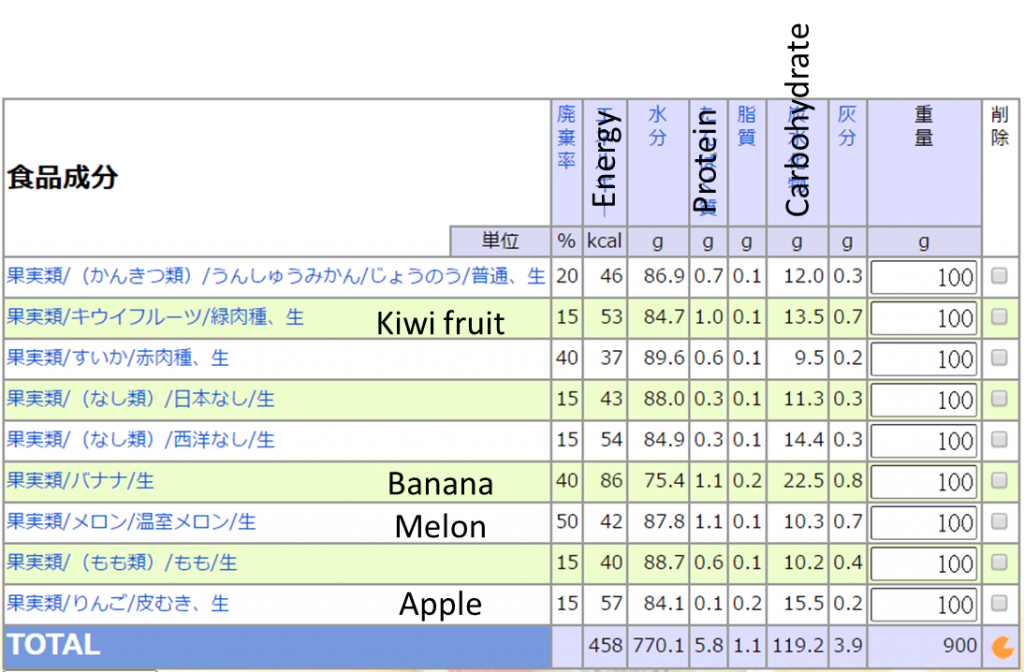What is the best food for the insects? : fruits, jellies and high-protein jellies
The food for rhinoceros beetles and stag beetles in wild is sap. However, this is not easy when we care these insects at home.
Fruits have long been recognized as an alternative of sap.
Commercial insect jellies became available when caring the insects became popular in Japan. In this post, I will introduce these foods for the insects.
Topics
1. Fruits and home-made sap
2. Commercial synthetic sap and jellies for the insects
3. Commercial high-protein jellies for the insects
4. Extra edition (Comparison of nutrition of fruits)
1. Fruits and home-made sap
Fruits have been common foods for the insects. Fruits like apples were introduced as food in the books written in 1970’s that instruct how to care them. Even now, fruits are still common foods for them. Apples and bananas seem popular recently.
Other than fruits, sugar or honey dissolved in water, fermented lactic drinks, and mixture of them are introduced in some old books.
Comparison of nutrition of fruits is provided in the bottom of this page as topic 4.
2. Commercial synthetic sap and jellies for the insects
A synthetic sap was available when I started caring rhinoceros beetles and stag beetles in early 1990’s. A nozzle was connected to a plastic tank so that a user could easily distribute synthetic sap onto a wood.

This is easier than giving fruits because this lasts longer and does not require to use a knife. I could not find when this came to the market, but I found a clue in books. Books published in 1985 and 1989 mentioned that there were commercial synthetic sap already. Still we cannot know how much popular it was, but at least they were in the market in late 1980’s.
Jellies in a cup is also popular now.

3. Commercial high-protein jellies for the insects
The first generation of the synthetic sap and jellies were not nutritionally perfect, although they were convenient. In the book 『クワガタムシ飼育のスーパーテクニック』(1996), the author pointed out that the commercial sap and jellies had problems when the insects (in his case, Dorcus hopei binodulosus) were mating and laying stage.
Below sentences are copied from the book and translated by Suzukake.
“They brought less eggs. In the worst but often case, a female ate a male.”
“I found that these foods contained too much sugar but less protein, which was required for the stag beetles, by using an infrared analyzer and saccharimeter.”
“When the stag beetles were fed by jellies with high protein content, they battled less.”
“Natural sap from oak tree contains more than 3.0% of protein at highest”
In the same year, high-protein jelly appeared in an advertisement in 『月刊むし』 (a monthly journal of entomology).
It is said that high-protein jellies provide more eggs and reduce the risk of attaching a male by a female.
Recently, we can find both 2. and 3. in stag beetles shops and even in DIY stores.
4. Extra edition (Comparison of nutrition of fruits)
I compared nutrition of fruits using Food composition Database provided by MEXT (Ministry of Education, Culture, Sports, Science and Technology).

We can see a banana contains much protein. Especially when a breeder cares about something in 3., a banana looks good choice. I should note that banana is cheap!
A melon also contains much protein, but who can serve a expensive melon everyday for stag beetles?
A kiwi fruit contains equivalent protein to a banana although I have not heard kiwi as food for the insects.
4 thoughts on “What is the best food for the insects? : fruits, jellies and high-protein jellies”
Your article is very good for new beetle breeders. Can I translate this post in Thai on my website.
Hi Wichayut, I am happy to hear your proposal. Let me contact you separately so that I could tell you simple conditions to translate the post on your website.
I confirmed you properly cited this post with URL. Thank you for contacting me. It is nice to see the content is now read in Thai language.
First of all, I apologize you to reply you late.
Here is the linked: https://tigerbeetlebreeding.com/why-should-we-feed-beetle-jelly-for-our-beetles/?v=a617fe8cfd7b